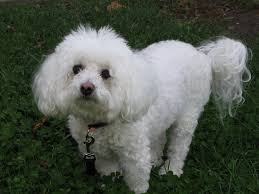The stories about the origins of the Bichon Frise are a strange mixture of scientific facts and tales of fiction. Acknowledged during the twentieth century, in 1933, this breed is said to be more than two thousand years old. What we can tell for sure, judging by the scientific evidence, is that this breed was very popular during the sixteenth century.

All over the Mediterranean region, kings, queens and other people with royal blood used to favor these white, merry dogs as pets. The tales say that the breed's name, meaning curly white lap dog in French, was given to it by the president of the Standard Committee of FCI, in order to end the endless debate between breeders.
Today, the Bichon Frise can be found all around the world, from Australia to the United States, being adopted mainly as pets and for dog contests.
This is a small dog, with a weight of approximately 5 to 10 kg, and a height of about 40 cm. Its back is large - for a dog of its size - and muscular, slightly arched. It has a wide chest, allowing the legs to be very mobile. The head is in harmony with the rest of the body and is well proportioned. The muzzle is not necessarily stiff or pointy, and it ends with a round, black nose. The playful eyes are black, usually round-shaped. The ears, medium in size, are usually droopy, but erect when the dog is alert. The coat is mostly white, possibly grey, and curly. The tail is groomed and carried over the back. Although some people say that this dog never sheds its fur, it is not entirely true. It does shed, but the amount of hair left here and there is often small. This is the reason why people allergic to dogs prefer the Bichon Frise over all other breeds.
This dog is renowned for its cheerful attitude and also for being very sociable with both people and other pets. Due to its energetic and playful personality, it makes a great playing partner for small children. Still, we must keep in mind that it demands a lot of attention, and adopting a Bichon at the same time with having a baby can be rather time and energy consuming. This does not need a lot of exercise, because it is active almost all day long even indoors, but, from time to time, a day out in the park is more than welcome.
The real issues with the Bichon Frise are also related to its sociable nature. Being so fond of human affection, it can easily become depressed when neglected. If left at home alone for long periods of time, it should have plenty of toys and an open TV around, just to keep it busy. When these things do not help, it will probably start barking and making a lot of noise, possibly irritating some neighbors. But this is just its way of asking for our attention.
In optimal conditions, it can live up to 18 years, which is a lot for dogs. We could say that the Bichon Frise enjoys life around humans so much that it cannot bear to say goodbye.




